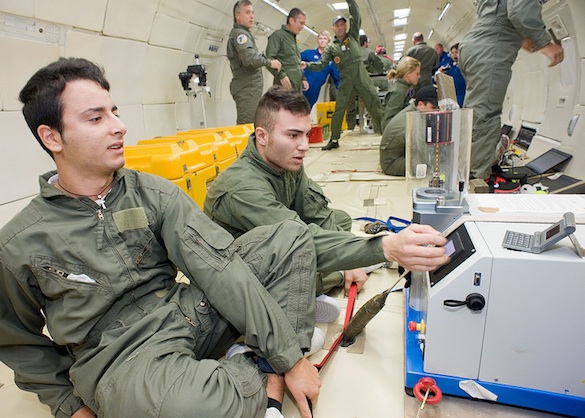Sintering of Composite Materials under Reduced Gravity Conditions
PI: Carmelo Mandarino, Advanced Technical Institute I.T.I.S "E. Fermi"
PI: Carmelo Mandarino, Advanced Technical Institute I.T.I.S "E. Fermi"

- TA07 Human Exploration Destination Systems
The objectives of the experiment are to study how the reduced gravity conditions influence the formation of the micro-structures in the sintering process of powder materials, and to demonstrate that materials obtained through this process have better characteristics of strength and uniformity as compared to ground-based processes. This is a big advantage for applications to space exploration (construction of moon bases using lunar soil powder), and to the production of shaped materials for industry (alloys, filters, bearings or special objects).
The experiment hardware has been assessed at TRL-6 as it can be considered as a high fidelity prototype of the one intended for materials processing in space. Results from the parabolic flights may advance the maturity of the technology to the following levels, involving the construction of a fully automated machine capable of extracting and processing the lunar soil, in order to produce locally the materials to be used by human settlements on the Moon.
The innovative process carried out by the experiment will demonstrate the composite powders' sintering under reduced gravity and in vacuum conditions, which can allow the possibility of obtaining high quality materials for ISFR (In Situ Fabrication and Repair) and ISRU (In Situ Resource Utilization) for applications in reduced gravity environment, such as the Moon and Mars surfaces. NASA and other International Space Agencies as well as private commercial organizations and companies can benefit.
The objective of the parabolic flight campaign is to submit to sintering temperature in lunar gravity conditions some pre-compacted samples of simulated lunar soil powders, to be compared with composite materials obtained in 1-g using the same process. Expected results are that samples processed at reduced gravity will show a better particle spread and agglomeration, which will improve their thermal & mechanical characteristics.
The test apparatus consists of an induction heater furnace, capable of processing pre-compressed composite material samples in a vacuum chamber according to computer-controlled temperature cycles. Two operators are required for monitoring the cycles and replacing the samples in the chamber.
Technology Details
-
Selection DateAFO3 (Mar 2012)
-
Program StatusCompleted
- 2 Parabolic
Development Team
-
PICarmelo Mandarino
-
OrganizationAdvanced Technical Institute I.T.I.S "E. Fermi"
-
SponsorAdvanced Technical Institute “E. Fermi", Fuscaldo, Italy
-
PartnersDesign Team: C.Mandarino, A.Caglianone, G.Panza, Advanced Technical Institute “E.Fermi”, Fuscaldo, Italy.
-
More Information

